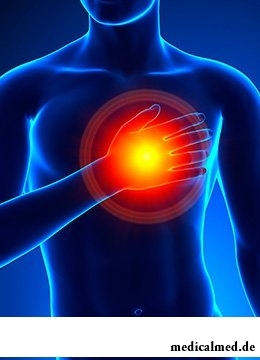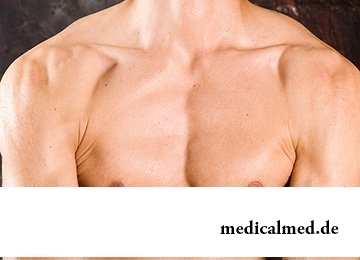





Gynecomastia
 The gynecomastia is one - or bilateral high-quality increase in mammary glands at men. Distinguish a false and true form of pathology. In the first case the gynecomastia is caused by fatty deposits at the excess weight, in the second – growth of tissue of mammary gland.
The gynecomastia is one - or bilateral high-quality increase in mammary glands at men. Distinguish a false and true form of pathology. In the first case the gynecomastia is caused by fatty deposits at the excess weight, in the second – growth of tissue of mammary gland.
Reasons and symptoms of a gynecomastia
The true gynecomastia at men is caused by the following reasons:
- Ratio distortion of estrogen and testosterone in an organism. Such state is often observed at insufficient functioning of gonads, hormonal and active tumors of testicles, a hypophysis, adrenal glands, lungs, a pancreas and stomach, and also at an addisonovy disease, inflammatory processes in testicles and adenoma of a prostate;
- Giperprolaktinemiya – increase in secretion of hormone of prolactin at a hypothyroidism and tumors of a hypophysis;
- The diseases connected with disturbance of exchange processes (obesity, a diabetes mellitus, a diffusion toxic craw, etc.);
- Other diseases of not endocrine character (cirrhosis, cardiovascular or renal failure, injuries of a thorax, HIV infection, etc.);
- Reception of a number of drugs which influence receptors of ferruterous fabric raise products of prolactin or estrogen, have toxic effect on testicles, etc. The gynecomastia in men is caused by anabolic steroids, metronidazole, corticosteroids, enalapril, verapamil, Cimetidinum, the creams containing estrogen, and many other means;
- Alcohol intake and drugs (marijuana, heroin).
The most characteristic symptom of a gynecomastia – increase in fabric of chest gland and emergence of consolidations in it. Sometimes at touch there are painful feelings which periodically decrease and disappear absolutely.
Diagnosis of pathology
Before removal of a gynecomastia, or its treatment, initial inspection which includes is necessary:
- Primary survey of the patient;
- Assessment of extent of development of secondary sexual characteristics;
- Palpation of testicles and mammary glands;
- Clarification of the family and medicinal anamnesis;
- The analysis of the available diseases;
- Detection of alcohol or drug addiction.
If gynecomastia signs are found, consultation of the endocrinologist, and also careful hormonal inspection is required. Determine by methods of laboratory diagnosis the content in blood of such hormones as: testosterone, oestradiol, thyrotropin, prolactin, CGP (chorionic gonadotrophin of the person), FSG (follicle-stimulating hormone) and LH (luteinizing hormone).
(False or true) apply ultrasonography of mammary glands to detection of a tumor of a breast and definition of character of a gynecomastia.
Conservative treatment of a gynecomastia
At the first stage of a disease (within four months after the beginning of growth of ferruterous fabric) it is possible to reduce the volume of mammary glands by methods of conservative therapy. At the same time it is rather simple to get rid of a gynecomastia without operation. The hormonal therapy normalizing balance of testosterone and estrogen, and as a result, promoting reduction of mammary glands is for this purpose appointed.
At conservative treatment of a gynecomastia use the following drugs:
- Anti-oestrogenic means (for example, Tamoxifenum). They are appointed in case of the excess content of estrogen in a male body. Anti-estrogen blocks this subclass of steroid hormones and does not allow them to influence mammary glands. Use of such drugs, despite their efficiency, is limited to numerous side effects;
- Testosterone is a male sex hormone which is appointed at decrease in its level in an organism. Positive effect of drug is especially noticeable at a hypogonadism which is characterized by insufficient secretion of androgens at an underdevelopment or damage of gonads. However at a physiological teenage gynecomastia at men purpose of testosterone is not always effective.
Surgical treatment of a gynecomastia
In cases when conservative therapy does not yield desirable result or it is initially clear that drug treatment will not help (for example, at tumoral defeats), an operative measure is carried out. During surgical removal of a gynecomastia excision of chest gland and the subsequent recovery of its physiological contour is carried out.
Indications to operational treatment are:
- Large volume of ferruterous fabric;
- Pronounced cosmetic defect;
- Age of pathology over a year.
Operations at a gynecomastia happen the following types:
- Endoscopic mastectomy through a section in axillary area (at small increase in mammary glands);
- Hypodermic mastectomy from a periareolyarny section with preservation of an areola;
- Hypodermic mastectomy with liposuction.
An operation on removal of a gynecomastia is well undergone by patients and does not demand long hospitalization and rehabilitation. In the first days after it hematomas and small hypostasis, and also a sensation of discomfort in a breast can be observed. For 2-3 weeks after surgical intervention it is recommended to wear the special dragging-away linen which helps to reduce skin and to create the correct muscular contour. Within a month it is necessary to exclude exercise stresses. The recovery period for each patient is individual, and the final result is swept up approximately in 12 weeks.
 Contraindications to removal of a gynecomastia and operation following:
Contraindications to removal of a gynecomastia and operation following:
- Disturbance of coagulability of blood;
- Arterial hypertension;
- Endocrine diseases;
- Heavy pathologies of cardiovascular system;
- Oncological and infectious diseases;
- Breast injuries;
- Low contractility and elasticity of skin.
At long existence of a gynecomastia the risk of development of cancer of mammary glands increases. Therefore if in the presence of this pathology bloody allocations from nipples appear, consolidations are formed, skin over education changes, axillary lymph nodes increase, it is necessary to see a doctor urgently.
Each person has not only unique fingerprints, but also language.

Several decades ago the basil (the district khan, реан, Reagan) was considered as a part of the Caucasian or east cuisine, but today it is strong for...
Section: Articles about health
Visit of doctors – business not the most pleasant, and many people do not hurry to undergo necessary planned inspections. Such behavior is extremely thoughtless and improvident. Our health is necessary not only to us: wellbeing of darlings, children, grandsons and престар...
Section: Articles about health
On the head of the person about one million hair follicles, or as they are called still, hair bulbs are located. At the time of the birth most of them is in the "sleeping" state, but within several weeks follicles become more active, and from them hair begin to grow. Intensity of this process is individual, and during life it can change. Genetic predisposition, a physical and emotional state, aggressive influence affects the growth rate of hair out of...
Section: Articles about health
The endocrine system carries out in a human body extremely important role, practically all processes of life activity регулируютс...
Section: Articles about health
It is pleasant to state a possibility of improvement of quality of life of people with problems of functioning of secretory system. Efforts of talented inventors created products which will be able to provide normal life activity of clients with moderate degree for...
Section: Articles about health
All parents are ready to what the baby often and pisat much. Since then, as the absorbing diapers strongly became current, keeping of the kid in dryness does not represent any problems. But if the grown-up kid continues to urinate in panties, parents begin to feel concern – whether it is normal, or the kid has an urine incontience? Let's try to understand what is enuresis why it arises at children and at what age it is necessary to begin it to treat....
Section: Articles about health
Sugar - the digestible refined product which is not of special value for an organism of the modern person. Use...
Section: Articles about health
Each person supports all life a SARS about 200 times. The peak of incidence falls on cold season, but it is possible to get sick with a temperature and a pharyngalgia, and sometimes and very possibly, even during a heat. The reasons for development of catarrhal diseases exists множество:...
Section: Articles about health
Many of us, probably, noticed more than once that from intellectual loadings at some point the brain as though "overheats" and "assimilation" of information is strongly slowed down. Especially this problem urgent for persons of age becomes more senior than fifty years. "Already badly I think", "the head will burst now", "memory as if is disconnected" - here that wants to be told at the time of information overload....
Section: Articles about health
Some people consider what for medicine of the 21st century of secrets in the field of health of the person almost does not exist. It absolutely not so. Than Bol...
Section: Articles about health
All got used long ago that, having addressed the plastic surgeon, it is possible to modify natural parameters of a figure or to minimize the damages put to appearance with ruthless time. Many people (preferential women) worldwide е...
Section: Articles about health
New year, wedding, birthday, office party – an occasion to drink at the Russian person will always be. How to reduce a negative impact of alcohol by an organism and to avoid a condition of strong intoxication? The most correct council – to refuse the use of alcoholic drinks. Council is true, but not always feasible. We offer several advice which will help you in cases when it is impossible to avoid alcohol intake....
Section: Articles about health
The naturopathy sometimes moves as the new direction of medicine, something like fashionable hobby, and there is nothing farther from the truth....
Section: Articles about health
Beauty shop – the place which is associated only with positive emotions: joy, pleasure, relaxation. However visit of salon where work with biological material of clients, not always harmlessly is conducted. Today it is known Bol...
Section: Articles about health
The unpleasant feelings connected with spring breakdown are familiar almost to each of us. Often happens that in March-April on the person weakness leans: he suffers from drowsiness, complains of bad mood, loss of interest in life and failures in affairs....
Section: Articles about health
Any person who faced a disease knows that treatment costs expensive. It belongs also to consultations qualified the specialist...
Section: Articles about health
For the person who daily since morning gathers for work it is very important to wake up vigorous and ready by day of work. Actually, each of us experiences difficulties with this, at first sight, simple business from time to time. On a condition of an organism after ночн...
Section: Articles about health
Memory is an ability of the central nervous system to fix, keep and as necessary to reproduce information on knowledge or skills received by the person or an animal during life. The mechanism of this process is up to the end not studied....
Section: Articles about health
The pancreas performs two functions in a human body: release of enzymes without which digestion carbohydrate is impossible...
Section: Articles about health
All like to sing. Small children with pleasure are engaged in a vocal, not especially thinking of hit in a melody. Adults most often hesitate, being afraid to show lack of talents in this area, and it is vain: singing is very useful for health....
Section: Articles about health
Season of activity of viral infections in the heat. Everyone can get sick, but probability of this unpleasant event it is possible and it is necessary to minimize. There is a number of rules, following to which will help or to avoid absolutely infection with flu or a SARS, or to have an illness benign and without essential complications. About ways of prevention of seasonal infections the speech in this article will also go....
Section: Articles about health
It would seem, about it there can be no disagreements: water is necessary for a human body for normal zhiznedeyatet...
Section: Articles about health
Partial and the more so full loss of hearing significantly reduces quality of life. Difficulties with communication lead to loneliness and isolation. The person who badly hears experiences difficulties with social and professional implementation, quite often has problems in...
Section: Articles about health
Modern footwear is extremely various. It stopped being only protection for legs long ago. Today shoes, boots, barefoot persons choose not so much proceeding from their convenience and functionality how many being guided by outward, brand and an opportunity to add with them a stylish dress. At the same time, buying footwear, think of its safety a little. Meanwhile, many popular models can do essential harm to health....
Section: Articles about health
For residents of the countries of Southeast Asia various algas are an obligatory component of a daily diet. Their priest...
Section: Articles about health
You are office worker, the driver, the fan of winter sports or do not think of life without bicycle? You lead a slow-moving life and you move on the city only on the car? You have no constant partner and you do not love the protected sex? Attention! You one...
Section: Articles about health
The kid who was recently born is surrounded with love of adult family members and their cares without which the baby cannot exist. Some parents consider that gentle attachment and caress are quite enough that the child correctly developed and was happy, but it not so. It is important to know as much as possible about specifics of care of the baby, the reasons of his behavior and possible problems. Only the "able to see" love will provide to the little man that it is necessary for him....
Section: Articles about health
